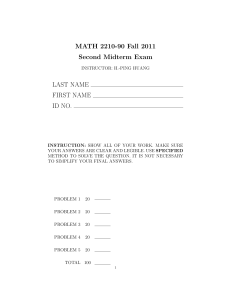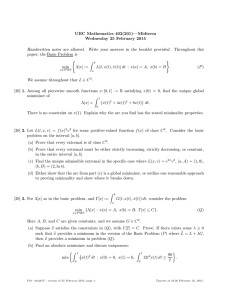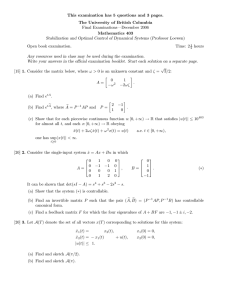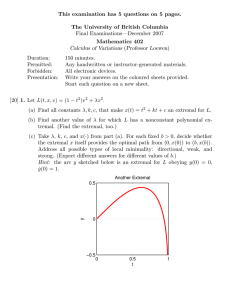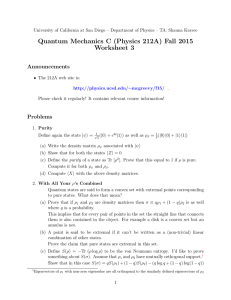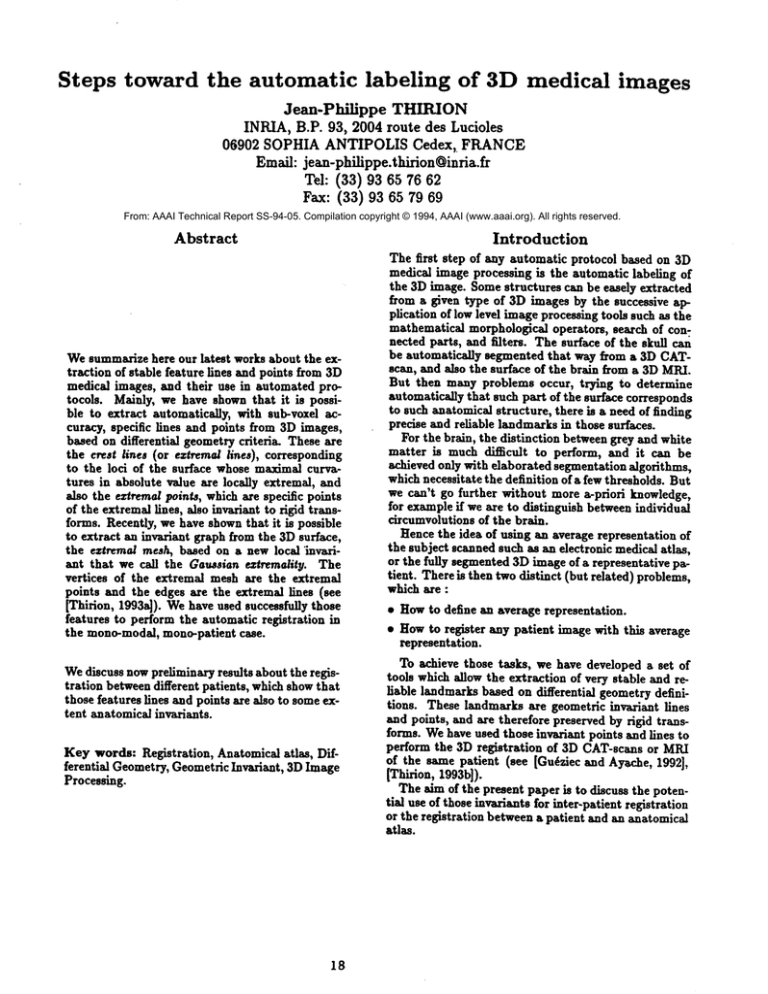
Steps
toward the automatic
labeling
of 3D medical
images
Jean-Philippe
THIRION
INRIA, B.P. 93, 2004 route des Lucioles
06902 SOPHIA ANTIPOLIS Cedex, FRANCE
Emsil: je~n-philippe.thirion@inria.fr
Tel: (33) 93 65 76
Fax: (33) 93 65 79
From: AAAI Technical Report SS-94-05. Compilation copyright © 1994, AAAI (www.aaai.org). All rights reserved.
Abstract
Introduction
Wesummarize here our latest works about the extraction of stable feature lines and points from 3D
medical images, and their use in automated protocols. Mainly, we have shown that it is possible to extract automatically, with sub-voxel accuracy, specific lines and points from 3D images,
based on differential geometry criteria. These are
the crest lines (or eztremal lines), corresponding
to the loci of the surface whose maximal curvatures in absolute value are locally extremal, and
also the eztremal points, which are specific points
of the extremal lines, also invariant to rigid transforms. Recently, we have shownthat it is possible
to extract an invariant graph from the 3D surface,
the eztremal mesh, based on a new local "invariant that we call the Gav.~sian eatremality. The
vertices of the extremal mesh are the extremal
points and the edges are the extremal lines (see
[Thirion, 1993s]). Wehave used successfully those
features to perform the automatic registration in
the mono-modal, mono-patient case.
Wediscuss nowpreliminary results about the registration between different patients, which show that
those features lines and points are also to someextent anatomical invaxlants.
Key words: Registration, Anatomical atlas, Differential Geometry, Geometric Invariant, 3D Image
Processing.
18
The first step of any automatic protocol based on 3D
medical image processing is the automatic labeling of
the 3D image. Somestructures can be easely extracted
from a given type of 3]) images by the successive application of low level image processing tools such as the
mathematical morphological operators, search of connected parts, and filters. The surface of the skull can
be automatically segmented that way from a 3D CATscan, and also the surface of the brain from a 3D MR/.
But then many problems occur, trying to determine
automatically that such part of the surface corresponds
to such anatomical structure, there is a need of finding
precise and reliable landmarks in those surfaces.
For the brain, the distinction between grey and white
matter is much difficult
to perform, and it can be
achieved only with elaborated segmentation algorithms,
which necessitate the definition of a few thresholds. But
we can’t go further without more a-priori knowledge,
for example if we are to distinguish between individual
circumvolutions of the brain.
Hence the idea of using an average representation of
the subject scanned such as an electronic medical atlas,
or the fully segmented 3D image of a representative patient. There is then two distinct (but related) problems,
which are :
¯ Howto define an average representation.
¯ Howto register any patient image with this average
representation.
To achieve those tasks, we have developed a set of
tools which allow the extraction of very stable and reliable landmarks based on differential geometry definitions. These landmarks are geometric invariant lines
and points, and are therefore preserved by rigid transforms. Wehave used those invariant points and lines to
perform the 3D registration
of 3D CAT-scans or MRI
of the same patient (see [Gu~ziec and Aysche, 1992],
lThirion,1993b]).
The Aimof the present paper is to discuss the potential use of those inv~rinnts for inter-patient registration
or the registration between & patient and an anatomical
atlas.
The extraction of stable
the iso-surface hypothesis
features
The extremal
[’he use of iso-surfaces is now widespread in medical
mage processing. An iso-surface in a 3D image is the
urface defined as the interface between the regions of
he image whose intensity is greater or equal to a given
hreshold from regions whose intensity is strictly infeior. Weare very lucky in that, on the contrary to conentional 2D image processing studying the projections
f a 3D world, the intensity displayed in our medical
~ages are generaJ]y representing the density of matter
t a given location in space. This is an objective meaLtrement, independent from lightning conditions and
"ithout casted shadows, or occlusion problems, which
lakes the iso-contour (or iso-surface) hypothesis appli¯ ble to our images.
Whenthe iso-surface hypothesis is not directly apUcable to ~ given type of medical images, a preo
;gmentation step based on mathematical morphologid operators generally suffices to restore the hypothesis
n that way, we are able to extract automatically the
irface of the brain, or of the ventricles from the MRI
! the brain).
’he global topological
properties
o-intensity contours and surfaces have several many
teresting global topological properties which are :
they are complete, in the topological sense, that is,
the surface has no holes, and the curves are closed.
they are orientable : we can distinguish between the
inside and the outside. For curves, the left handed
orientation convention can be applied.
they are not self-intersecting.
What is remarkable is that those properties can be
¯ intalned by local algorithms. Wehave designed
ch local algorithms for extracting iso-surfaces and isontours and proved the topological correctness of those
~orithms in [Thirion and Gourdon, 1993].
he extremal lines and points
the same paper, we have shown how to extract and
~pute the differential properties of those 3D surfaces
ectly from the differentials of the 3£) image, and how
extract the lines corresponding to the extremal values
the two principal curvatures/~1 and/~2 (a work inilized in [Monga et d., 1992]). Wehave named those
.~s the extremal lines, and have characterized them
the zero-crossing of an operator, the extremality cocient e~, which is the directional deriwtive of one of
two principal curvature: e~ -- ~k~. ~.
n [Thirion, 1993b], we have defined specific geomet;-variant points of those extremal lines, the eztrema/
at.s, which are the simultaneous extrema of both
ncipul curvatures: el -- 0,e2 -- 0. The generalLion of the extremal points to NDis described in
Lirion and Benayoun, 1993], with applications to the
image hypersurface corresponding to a 3D image.
19
mesh
Recently, we have introduce the notion of eztrema/
meah, which is a graph of the surface whose vertices are
the extremal points and whose edges are the extremal
lines (see [Thirion, 1993a]). As for extremal lines and
points, this graph is invariant to rigid transforms. It
is somehowthe generalization to curved surfaces of the
representation of polyhedral surfaces as vertices, edges
and faces.
The extremal mesh has numerous interesting
topological and geometrical properties, which are ensured
by a new local invariant of 3D surfaces, also defined in
[Thirion, 1993a], that we have called the Gaussian extremality Eo. Mainly, Ee -- ele2 with some precautions
about the orientation. Eg is invariant with respect to
a positive isometry, or to a change of orientation of the
surface, and inverts with a negative isometry. Wehave
been able to design also an algorithm to extract the
extremal mesh which maintains the topological properties.
The Gaussian extremality Pnd the extremal mesh are
probably one of the major steps in the understanding
of 3D curved surfaces.
The use of the
nat-~
symmetry
Wehave successfully used our geometrical features (extremal lines, points, mesh) to perform rigid matching
between different images of the same patient. This
enables us to compute the standard deviations of the
measured differential characteristics attributes due to
the acquisition process (curvatures, principal directions,
Fr~net trihedron, ... ).
To perform inter-patient registration, we have first to
figure out if those geometric invaxiants are also anatomical ;-variants, that is, to estimate the variability of
those quantities between different patients. Wehave
identified the study of the natural symmetry of some
organs as a potential way to investigate this.
A head, for example, is somehowsymmetrical with
respect to the sagittal plane. Weare able to find automatically this sagittal plane by :
¯ extracting
the extremal mesh from the 3D image.
¯ applying a negative isometry to the mesh (this can
be easely performed, for example by inverting the z
coordinates).
¯ finding the best rigid transform to match the skull
and its inverted version.
This method produces numerous advantages :
¯ it allows us to measure the ~intra-patient ~ variability (or self-variability), which is lying somewherebetween the acquisition variability and the inter-patient
variability.
¯ we can eliminate non-symmetric features, which are
likely to be unstable features, due to noise,
¯ once that the eagittal planes of two images are identiffed, this restrains the rigid transform to be found
between those two images to only 3 parameters.
We can also take advantage of the anti-symmetric
nature of the Ganssian extremality operator : the negative
isometry inverts the sign of Eg, therefore the E
0
of a symmetric object is unchanged.
Of course, all organs are not symmetrical, but the
study of the symmetryis very interesting for head examination, for example.
Inter-patient
registration
experiments
The transform existing between two images of the same
rigid object is well defined (although it is generally not
known). Hence we can have objective measurements of
the quality of the match. On the contrary, the registration between two different patients depends on an
erbitrary definition of what "good" matches are, which
in turn depends on what we intend to do with this transform.
Objective
and subjective
measurements
Defining the good match being the transform which
minimizes the distance between the surfaces of the two
objects is not sufficient. Wecan always continuously
deform one of the image to transform it into the other
image, but if we trace the trajectory of a point from one
of the surface to the other one, some of those "metamorphic" methods will make a specific point, such as
for example the tip of the nose, correspond to the tip
of the nose of the second surface, while some other deformation methods will make it correspond with any
arbitrary point of the second surface. Only the first
kind of method can be used for automatic labeling.
There is an ira.. portant risk to see manyvery unscientific research works describing inter-patient registration methodsif the only criterion used to appreciate the
quality of this registration is the distance between the
two registered surfaces :
Prom our point of view, the evaluation of interpatient registration methods must answer the following
questions :
¯ what is the class of transform which is explored ?
(sfline, splines, etc... ).
¯ what invariant features are used to perform the minimization between the two images (surfaces ? lines
specific points ?).
The first methods of inter-patient registration which
]~ave been proposed, for e~ample the stereotsxic atlas of T~lalrach (see [Talsirach and Tournoux, 1988]),
~se a few specific anatomical points, and rigid or s/Bne
transform.
The advantages
of the extremal
lines
and
points
The extremal points and the extremsl lines have many
advantages to be used as landmarks for inter-patient
2O
registration :
s their extraction is automatic, therefore they do not
depend on the subjectivity of a human operator.
¯ there is a relatively large number of them, that is
much more than what a human operator can extract
manually : typically 3000 extremal points for a 3D
CAT-scanof the head, and 50000 points defining the
extremal lines. This leads to a better precision of the
registration.
¯ their numberis also relatively small, in that the density of the extremal points in the 3]:) image is very
low : typically, 3000 from a 5 million voxeis image,
that is, less than 1/1000zh. Hence there is muchless
ambiguity when matching extremal points, compared
with matching arbitrary surface points (which cover
typically 1/10th of the voxe]s in the image). Furthermore, the compactness of those feature points allows
us to use more evolved algorithms, with still acceptable memorysize and cpu time.
¯ there are geometric invarlants associated with those
points and lines (curvatures, principal directions,
Fr~net trihedron, ... ), which characterize those features and tremendously reduce the complexity of the
matching process. The first step is to use the classification of the extremal points and lines into 16
different distinct classes (a feature of one class cannot correspond to a feature of another class, see
[Thirion, 1993a]).
¯ the first order of any set of acceptable transforms is
the rigid transform, these features are invariant to
rigid transforms.
Qualitative
results
We have been able to verify experimentally some of
our assumptions about the inter-patient stability of our
landmarks. We have a set of 3D CAT-scans of heads,
where we have been able to automatically extract the
extremal points and lines. The principal anatomical
lines have been successfully extracted in all those skulls
: submandibular, temporal, orbital lines, and also the
foramen occipital.
A particular point of the foramen
occipital, the "opisthion’, has been identified as a particular extremal point in all of those 3D images.
Wehave also developed a tool, based on 3D lines to
find rigid, afline, or higher order trsasforms between all
those skull images.
Weare studying now the extremal point invariance
amongpatients. Wehave for example extracted a set of
ten specific extremal points (including the opisthion),
for which we have verified the self-invariance (that is,
points which have a symmetrical counterpart), and we
have been able to find back automatically the ten corresponding extremal points in the images of other patients, where they are also self-invariant.
This revealed surprisingly few differences between our patients
a standard deviation of about 5 millimeters, all being
<lult Caucasians).
Although preliminary, those results are very encouraging.
Perspectives
?here are two kinds of stability : the geometric and the
opologic stability.
For example we have shown that
he maximain absolute value of the largest principal
urvature are geometrically more stable than the minma. But we can also show that there is always aline of
ainima between two lines of maxima, hence this kind
.f lines is topologically as stable as maximallines.
The extremal mesh express very strong topological
,roperties, and as it supersedes the extremal points and
nes, it is also very stable geometrically. Until now, we
ave mostly explored its geometrical invarlance proprties, but the topological invariance properties must
|so be explored, for example with graph matching techiques.
Wewill have however to work first with simpler sur~ces than the skull surface, for which the extremal
lesh can be very complicated. For example, we intend
o perform studies on the surface of brain ventricles.
Figure 1: The crest lines extracted from a 3D CT-scan
References
3u~ziec and Ayache, 1992] A. Gu~ziec and N. Ayache.
Smoothing and matching of 3D-space curves. In Proceedings of the Second European Conference on Computer Vision 1992, Santa Margherita Ligure, Italy,
May 1992.
Vlonga et al., 1992] Olivier Monga, Serge Benayoun,
and Olivier D. Faugeras. Using partial derivatives
of 3d images to extract typical surface features. In
Proceedings CVPR’912, Urbana Champaign, Illinois.
IEEE, July 1992. also an INRIA Research Report
(1599).
[’alairach and Tournoux, 1988] Jean Talairach and
Pierre Tournoux. Co.Planar Stereotazic Atlas of the
HumanBrain. Georg Thieme Verlag, Stuttgart - New
Tork, 1988.
~hirion and Benayoun, 1993] J-P Thirion and S. Benayoun. Image surface extremal points, new feature
points for image registration. Technical Report 2003,
INRIA, July 1993.
[’hirion and Gourdon, 1993] J-P.
Thirion
and A. Gourdon. The 3d marching lines algorithm :
new results and proofs, rapport de recherche INRIA,
(1881), March 1993.
~hirion, 1993a] J-P Thirion. The extremal mesh and
the understanding of 3d surfaces. Technical Report
2149, INRIA, December 1993.
.~hirion; 1993b] J-P Thirion. Newfeature points based
on geometric invariants for 3d image registration. INRIA research report, (1901), April 1993.
21
Figure 2: The anti-symmetric nature of the Ganssian "
extrema~ty

